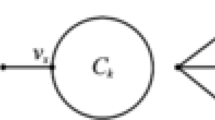Abstract
We define a \({D}_0\) graph to be a graph whose vertex set is a subset of permutations of n, with edges of the form \(\cdots \mathsf {bac} \cdots \leftrightsquigarrow \cdots \mathsf {bca} \cdots \) or \(\cdots \mathsf {acb} \cdots \leftrightsquigarrow \cdots \mathsf {cab} \cdots \) (Knuth transformations), or \(\cdots \mathsf {bac} \cdots \leftrightsquigarrow \cdots \mathsf {acb} \cdots \) or \(\cdots \mathsf {bca} \cdots \leftrightsquigarrow \cdots \mathsf {cab} \cdots \) (rotation transformations), such that whenever the Knuth and rotation transformations at positions \(i-1, i, i+1\) are available at a vertex, exactly one of these is an edge. The generating function of such a graph is the sum of the quasisymmetric functions associated to the descent sets of its vertices. Assaf studied D\(_0\) graphs in (Dual equivalence and Schur positivity, http://www-bcf.usc.edu/~shassaf/degs.pdf, 2014) and showed that they provide a rich source of examples of the D graphs of (Dual equivalence graphs and a combinatorial proof of LLT and Macdonald positivity, http://www-bcf.usc.edu/~shassaf/positivity.pdf, 2014). A key construction of Assaf expresses the coefficient of \(q^t\) in an LLT polynomial as the generating function of a certain D\(_0\) graph. LLT polynomials are known to be Schur positive by work of Grojnowski-Haiman, and experimentation shows that many D\(_0\) graphs have Schur positive generating functions, which suggests a vast generalization of LLT positivity in this setting. As part of a series of papers, we study D\(_0\) graphs using the Fomin-Greene theory of noncommutative Schur functions. We construct a D\(_0\) graph whose generating function is not Schur positive by solving a linear program related to a certain noncommutative Schur function. We go on to construct a D graph on the same vertex set as this D\(_0\) graph.






Similar content being viewed by others
References
Assaf, S.H.: Dual equivalence graphs and a combinatorial proof of LLT and Macdonald positivity. arXiv:1005.3759v5 (October 2013)
Assaf, S.H.: Dual equivalence and Schur positivity. http://www-bcf.usc.edu/~shassaf/degs.pdf (March 2014)
Assaf, S.H.: Dual equivalence graphs and a combinatorial proof of LLT and Macdonald positivity. http://www-bcf.usc.edu/~shassaf/positivity.pdf (August 2014)
Blasiak, J.: Haglund’s conjecture on 3-column Macdonald polynomials. arXiv:1411.3646 (November 2014)
Blasiak, J., Fomin, S.: Noncommutative Schur functions, switchboards, and Schur positivity. arXiv:1510.00657 (October 2015)
Bosma, W., Cannon, J., Playoust, C.: The Magma algebra system. I. The user language. J. Symb. Comput. 24(3-4), 235–265 (1997). Computational algebra and number theory (London, 1993)
Bron, C., Kerbosch, J.: Algorithm 457: finding all cliques of an undirected graph. Commun. ACM 16(9), 575–577 (1973)
Fomin, S., Greene, C.: Noncommutative Schur functions and their applications. Discrete Math. 193(1–3), 179–200 (1998). Selected papers in honor of Adriano Garsia (Taormina, 1994)
Gessel, I.M.: Multipartite \(P\)-partitions and inner products of skew Schur functions. In: Combinatorics and algebra (Boulder, Colorado, 1983), vol. 34 of Contemp. Math. pp. 289–317. Am. Math. Soc. Providence, RI (1984)
Grojnowski, I., Haiman, M.: Affine Hecke algebras and positivity of LLT and Macdonald polynomials. Preprint (2007)
Haglund, J.: A combinatorial model for the Macdonald polynomials. Proc. Natl. Acad. Sci. USA 101(46), 16127–16131 (2004)
Haglund, J., Haiman, M., Loehr, N.: A combinatorial formula for Macdonald polynomials. J. Am. Math. Soc. 18(3), 735–761 (2005)
Haglund, J., Haiman, M., Loehr, N., Remmel, J.B., Ulyanov, A.: A combinatorial formula for the character of the diagonal coinvariants. Duke Math. J. 126(2), 195–232 (2005)
Lam, Thomas: Ribbon Schur operators. Eur. J. Combin. 29(1), 343–359 (2008)
Lascoux, Alain, Leclerc, Bernard, Thibon, Jean-Yves: Ribbon tableaux, Hall–Littlewood functions, quantum affine algebras, and unipotent varieties. J. Math. Phys. 38(2), 1041–1068 (1997)
Lascoux, A., Schützenberger, M.P.: Le monoïde plaxique. In: Noncommutative structures in algebra and geometric combinatorics (Naples, 1978), vol. 109 of Quad. “Ricerca Sci.”, pp. 129–156. CNR, Rome (1981)
Leclerc, B., Thibon, J.-Y.: Littlewood–Richardson coefficients and Kazhdan–Lusztig polynomials. In: Combinatorial methods in representation theory (Kyoto, 1998), vol. 28 of Adv. Stud. Pure Math., pp. 155–220. Kinokuniya, Tokyo (2000)
Novelli, J.-C., Schilling, A.: The forgotten monoid. In Combinatorial representation theory and related topics, RIMS Kôkyûroku Bessatsu, B8, pp. 71–83. Res. Inst. Math. Sci. (RIMS), Kyoto (2008)
Schrijver, Alexander: Theory of Linear and Integer Programming. Wiley, New York (1986)
Stanley, R.P.: Enumerative combinatorics. Vol. 2, volume 62 of Cambridge Studies in Advanced Mathematics. Cambridge University Press, Cambridge, 1999. With a foreword by Gian-Carlo Rota and appendix 1 by Sergey Fomin
Acknowledgments
I am extremely grateful to Sergey Fomin for his valuable insights and guidance on this project and to John Stembridge for his generous advice and many detailed discussions. I thank Sami Assaf, Sara Billey, and Jennifer Morse for valuable discussions and Elaine So and Xun Zhu for help typing and typesetting figures.
Author information
Authors and Affiliations
Corresponding author
Additional information
This work was supported by NSF Grant DMS-14071174.
Electronic supplementary material
Below is the link to the electronic supplementary material.
Rights and permissions
About this article
Cite this article
Blasiak, J. What makes a \(\mathbf{D}_0\) graph Schur positive?. J Algebr Comb 44, 677–727 (2016). https://doi.org/10.1007/s10801-016-0685-7
Received:
Accepted:
Published:
Issue Date:
DOI: https://doi.org/10.1007/s10801-016-0685-7




